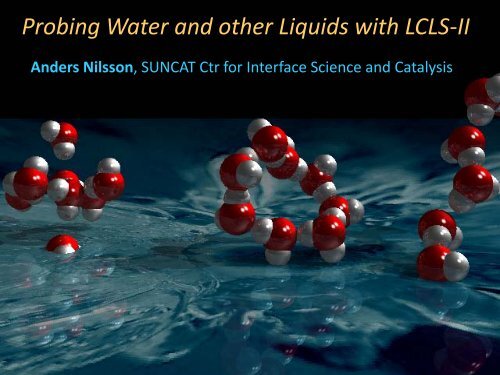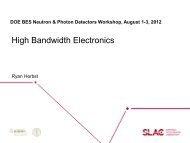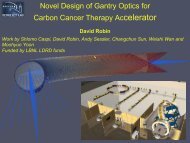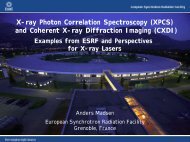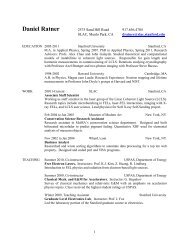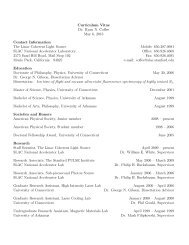Probing Water and other Liquids with LCLS-II - SLAC Portal ...
Probing Water and other Liquids with LCLS-II - SLAC Portal ...
Probing Water and other Liquids with LCLS-II - SLAC Portal ...
- No tags were found...
Create successful ePaper yourself
Turn your PDF publications into a flip-book with our unique Google optimized e-Paper software.
<strong>Water</strong> denser than ice<strong>Probing</strong> <strong>Water</strong> <strong>and</strong> <strong>other</strong> <strong>Liquids</strong> <strong>with</strong> <strong>LCLS</strong>-<strong>II</strong>Anders Nilsson, SUNCAT Ctr for Interface Science <strong>and</strong> CatalysisDensity of the liquid higherthan the solidNormal liquid (ethanol, gasoline,etc)Solid more dense than liquid
The Blue Planet
Access to Clean <strong>Water</strong>The Challenge Climate for the Change World <strong>with</strong> <strong>Water</strong> Climate Issues ChangeGore, Inconvenient Truth
<strong>Water</strong> denser than iceDensity of the liquid higherthan the solidNormal liquid (ethanol, gasoline,etc)Solid more dense than liquid
Density MaximumNormal liquiddensitydddddddddddd<strong>Water</strong>Ssssssssssssssssssssssss-50-25025 50 75 100Temperature/ °CAt the bottom of the glass is 4 °C water
High Heat CapacityIt stabilizes the temperature in the OceansOcean current stabilizes the climate
Anomalous Properties of <strong>Water</strong>Is<strong>other</strong>malCompressibilityHeat CapacityThermalexpansion=Vk B Tκ T =Nk B c p =Vk B TαDensity fluctuations Entropy fluctuations Cross of density <strong>and</strong>entropy fluctuationsDivergence towards a mysterious temperature of -45 °CP. Kumar, S. Han, H.E. Stanley, J. Phys.: Condens. Matter 21 (2009) 504108.
X-ray Spectroscopies <strong>and</strong> Scattering Data• XAS indicates predominant asymmetrical coordination <strong>with</strong>fewer H-bonds than in tetrahedral modelWernet et al., Science 304 (2004) 995• XES shows two motifs: strongly tetrahedral<strong>and</strong> very disorderedTokushima et al., Chem. Phys. Lett. 460 (2008) 387• SAXS shows fluctuating density inhomogeneityEnhanced upon coolingHuang et al., PNAS 106, 15214 (2009); 107, E45 (2010);JCP 133, 134504 (2010)•WAXS shows broad structural distributions<strong>and</strong> shell-structure (~12 Å) consistent <strong>with</strong>two structural motifs (<strong>and</strong> <strong>with</strong> SAXS)Huang et al. Phys. Chem. Chem. Phys. 13, 19997 (2011)
IceOpen spaces where nomolecules are presentIf molecules move to fill theopen space there will be anincrease in the density
Summary room temperature to -20 °CStrongly Distorted is related to local High Density Liquid (HDL)Tetrahedral is related to local Low Density Liquid (LDL)HDL <strong>and</strong> LDL fluctuationsTwo local structural different motifs≈1nm length scales at room temperatureIncreasing length scale <strong>with</strong> decreasing temperatureA. Nilsson <strong>and</strong> L. G. M. Pettersson, Chem. Phys. 389, 1 (2011).
Snapshot from MD at -20 °CPerspective on waterChem. Phys. 389, 1 (2011).Blue: High tetrahedralityYellow: High densityBox side length 100 Å
<strong>Probing</strong> bulk water <strong>and</strong> ice crystallization in "no-mansl<strong>and</strong>"; first results from the X-ray laser at StanfordCongcong Huang, Trevor McQueen, Jonas Sellberg, Hartawan Laksmono, Duane Loh, RaySierra, Christina Hampton, Dimitri Starodub, Dennis Nordlund, Martin Beye, Daniel Deponte 1 ,Andy Martin 1 , Andrew Barty 1 , Jan Feldkamp, Sebastian Boutet, Garth Williams, K. T. Wikfeldt 2 ,L. G. M. Pettersson 2, Mike Bogan <strong>and</strong> Anders NilssonSingle shot x-ray scattering50 femtosecond pulse<strong>SLAC</strong> National Accelerator Center/Stanford University Feb 20111Center for Free Electron Laser, Hamburg2Stockholm University
“No-Mans L<strong>and</strong>” below limit of homogeneous ice formationHomogenousIce NucleationLimit -38 °C-45 °C in “nomans l<strong>and</strong>”ρ(HDA)=1.17 g/cm 3ρ(LDA)=0.94Low DensityAmorphous Ice (LDA)High DensityAmorphous Ice(HDA)ρ(Ih)=0.92ρ(Ic)=0.92H. E. STANLEY “Mysteries of <strong>Water</strong>” Les Houches Lecture, May 1998Originally Proposed P. H. Pool <strong>and</strong> H. E. Stanley et.al Nature 360, 324 (1992)
Stability LimitRetracing SpinodalLiquid no longer stableIce is instantaneous formed -45 °CDifferent Models2 nd critical point modelHDL-LDL Liquid TransitionWidom line maximum HDL-LDL fluctuations -45 °CR. J Speedy J. Phys. Chem. 86, 982 (1982)A. C. Angell, Nature 331, 206 (1988)P. H. Pool et al., Nature 360, 324 (1992)Variation vid Critical Point at O KS. Sastry et al., Phys. Rev. E 53 , 6144 (1996). )
X-ray Emission SpectroscopyHDLLDLLDLHDL<strong>Probing</strong> population of HDL <strong>and</strong> LDL using XESExperiment in October at SXR, collaboration <strong>with</strong> Wernet et al HZB
<strong>Probing</strong> water at higher pressures <strong>and</strong> glassy formsHomogenousIce NucleationLimit -38 °C-45 °C in “nomans l<strong>and</strong>”ρ(HDA)=1.17 g/cm 3ρ(LDA)=0.94Low DensityAmorphous Ice (LDA)High DensityAmorphous Ice(HDA)ρ(Ih)=0.92ρ(Ic)=0.92H. E. STANLEY “Mysteries of <strong>Water</strong>” Les Houches Lecture, May 1998Originally Proposed P. H. Pool <strong>and</strong> H. E. Stanley et.al Nature 360, 324 (1992)
Much largerenhancements(fluctuations!)at lower TSAXS – Ambient to Supercooled RegimeAt low Q rangeS(Q) shows anunusual enhancementS 1Aζ + Q( Q) ∝ − 2 2F.T.Q1)k TnχBVery good fit to previous dataTHuang et al., PNAS 106, 15214 (2009); PNAS 107, E45 (2010); JCP 133, 134504 (2010)
Apparent Power Law – Widom LineCritical phenomena characterized by power laws <strong>with</strong> critical exponents.322nd critical point scenarioFluctuations between HDL/LDLPoole et al., Nature 360, 324 (1992).52Fit ζ to (apparent) powerlawξξ ε−νTIP4P-2005 simulationsBlue LDL Red HDLbased on inherent structure= 0<strong>with</strong>ε T / T −1=sHuang et al. JCP 133, 134504 (2010)K. T. Wikfeldt et al. Phys. Chem. Chem. Phys, 13, 19918 (2011).
<strong>Probing</strong> correlation length in no-mans l<strong>and</strong>Widom LineT2 nd critical pointPξWe need much higher intensity !!!T
Super hard x-ray diffraction study on water pair correlation functionAPS 11-ID-C: 115 keV photons <strong>and</strong> an amorphous Silicon area detectorCurrent CXIFourier TransformLong-range orderings(up to 1.4 nm) are visible!293 KCourtesy C. Benmore
Ordered StructuresEquilibrium PhenomenaDisordered StructuresNonequilibrium PhenomenaTransient StatesEra of Crystalline MatterConventional X-ray ProbesEra of Disordered MatterCoherent X-ray Probes1900 2000 futureCourtesy of H. Dosch
Coherent Diffraction Patternobtained from frozen liquid (glass)P. Wochner et al., PNAS 106, 11511 (2009)„Laser Speckles“
Hidden Local Symmetries fromHigher-Order Correlation Functions4-point correlationsMPI-MF DESY ESRFP. Wochner et al.PNAS 106, 11511 (2009)C Q(∆) = < I(Q,ϕ)I(Q,ϕ + ∆) > ϕ − < I(Q,ϕ) >2 ϕ< I(Q,ϕ) > 2 ϕ
Angular Correlations of H 2 ODetector Position 1 Detector Position 2 Detector Position 3∆ (º)∆ (º) ∆ (º)q (Å -1 )97.5 mm 122.5 mm 147.5 mmJan Feldkamp, Jonas Sellberg <strong>and</strong> Derek Mendez
Ultrafast XPCS using ‘Split Pulse’ ModeFemtoseconds to nanoseconds time resolutionUses high peak brilliancesplittersampletransversely coherentX-ray pulse from FELvariable delayContrastAnalyze contrastas f(delay time)sum of speckle patternsfrom prompt <strong>and</strong> delayed pulsesrecorded on CCD
Bonds vs. Entropylocalized bondsdelocalizedbondsBond EnergyEntropy
Perform pump-probeIR-THz <strong>and</strong> x-rayProbe stability <strong>and</strong> dynamics ofHDL <strong>and</strong> LDL structuresSelective excitations in libration b<strong>and</strong>Probe XES, SAXS, CXIPump-probe<strong>Water</strong>IR spectraIceFrustrated Motion in H-bondsFrom Y. Maréchal, The Hydrogen Bond <strong>and</strong> the<strong>Water</strong> Molecule, Elsevier (2007)
<strong>Water</strong> <strong>and</strong> BiologyHydration layer in DNA <strong>and</strong> Proteins
Interfacial <strong>Water</strong>
Wish list <strong>LCLS</strong> <strong>II</strong>• High Intensity (>10 mJ) small focus for CXI experiments• Higher Energy 30-100 keV for large Q space (3 rd harmonics)• Detector <strong>with</strong> a uniform response• X-ray correlation spectroscopy from 100fs to ms• THz – IR pump• Soft x-ray dedicated liquid endstation• Stimulated emission• Different sample geometries, high pressure <strong>with</strong> a pulse source• End station for surfaces <strong>and</strong> interfaces, both soft <strong>and</strong> hard x-rays


